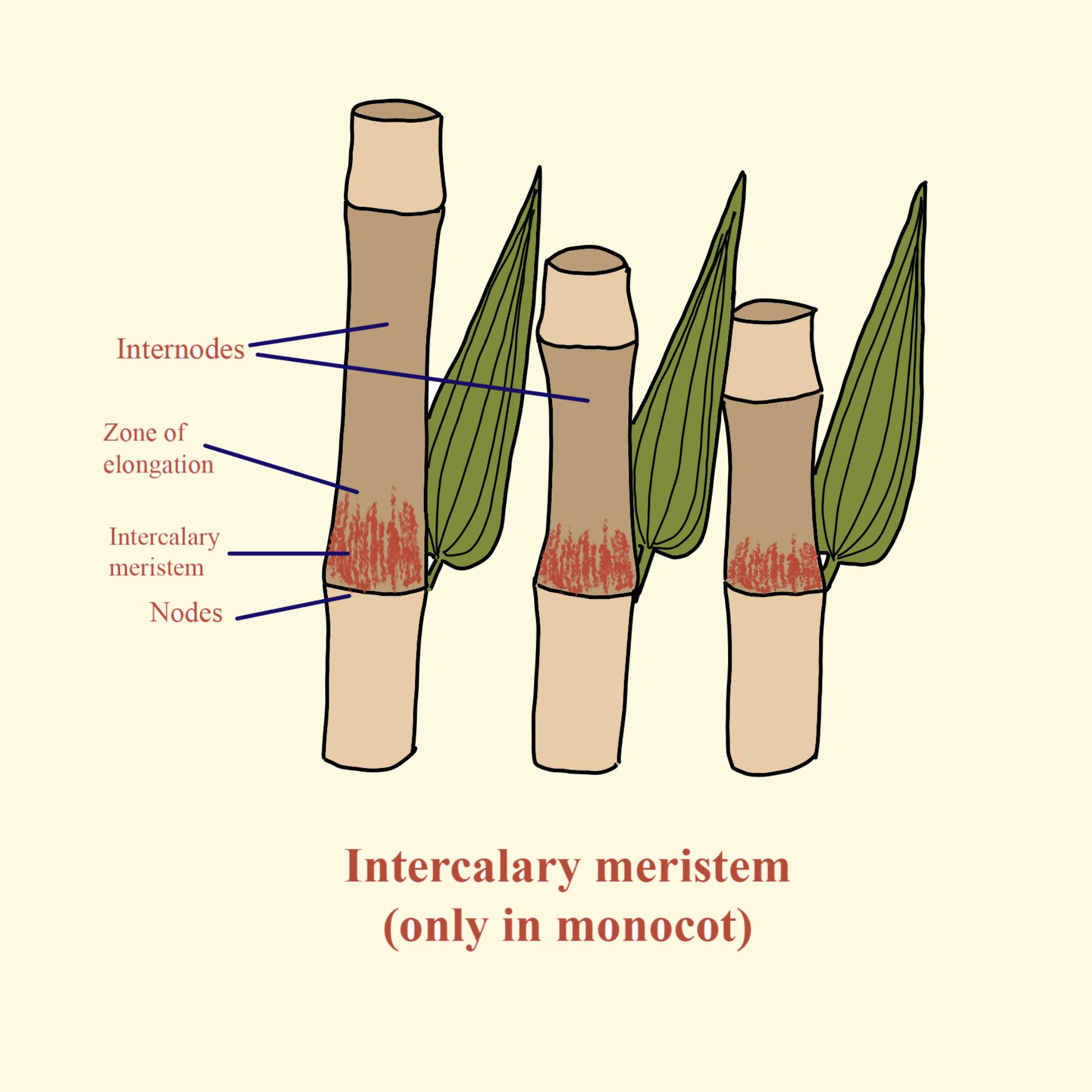
Intercalary meristem at base of Pinus leaves or nodes of grasses is responsible for
(a)Primary growth
(b)Secondary growth
(c)Phellem formation
(d)Abscission formation
Answer
566.7k+ views
Hint: The intercalary meristem at the base of Pinus leaves or grass nodes is responsible for a mechanism that results from the rapidly dividing cells at the shoot tip and root tip in the apical meristems. They occur mainly in tips, roots, and apiece.
Complete answer:
Primary growth is due to the intercalary meristem at the base of leaves or grass nodes. Meristems are graded as apical at the root and shoot tips, lateral at the vascular and cork cambia, and intercalary at internodes of stem regions between the places where leaves connect, and leaf bases, by their position in the plant.
Intercalary meristem cells, as apical and lateral meristems do, have the ability to divide and create new cells. They differ, however, in being found between mature areas of tissue, such as at the base of grass leaves found on mature stem tissue.
At the apices, or tips, of stems and roots, most primary growth takes place. Subsequent cell elongation leads to primary growth as well. During primary growth, the growth of shoots and roots allows plants to seek water (roots) or sunlight (shoots) on a continuous basis.
Additional Information: Secondary Growth:
-The increase in stem thickness resulting from secondary growth is due to lateral meristem activity, which is not present in herbaceous plants. The vascular cambium and, in woody plants, the cork cambium contain lateral meristems.
So, the correct answer is, ‘Primary growth’.

Note: -The increase in stem thickness resulting from secondary growth is due to lateral meristem activity, which is not present in herbaceous plants. The vascular cambium and, in woody plants, the cork cambium contain lateral meristems.
They are found in some plant stems. They can be present either at the base of the internode (for example, grass, bamboo, Equisetum, etc.) or at the base of the internode (for example, Mint). They are also present, e.g., Pinus, at the base of leaves. Through the action of this meristem, leaf length increases.
Complete answer:
Primary growth is due to the intercalary meristem at the base of leaves or grass nodes. Meristems are graded as apical at the root and shoot tips, lateral at the vascular and cork cambia, and intercalary at internodes of stem regions between the places where leaves connect, and leaf bases, by their position in the plant.
Intercalary meristem cells, as apical and lateral meristems do, have the ability to divide and create new cells. They differ, however, in being found between mature areas of tissue, such as at the base of grass leaves found on mature stem tissue.
At the apices, or tips, of stems and roots, most primary growth takes place. Subsequent cell elongation leads to primary growth as well. During primary growth, the growth of shoots and roots allows plants to seek water (roots) or sunlight (shoots) on a continuous basis.
Additional Information: Secondary Growth:
-The increase in stem thickness resulting from secondary growth is due to lateral meristem activity, which is not present in herbaceous plants. The vascular cambium and, in woody plants, the cork cambium contain lateral meristems.
So, the correct answer is, ‘Primary growth’.

Note: -The increase in stem thickness resulting from secondary growth is due to lateral meristem activity, which is not present in herbaceous plants. The vascular cambium and, in woody plants, the cork cambium contain lateral meristems.
They are found in some plant stems. They can be present either at the base of the internode (for example, grass, bamboo, Equisetum, etc.) or at the base of the internode (for example, Mint). They are also present, e.g., Pinus, at the base of leaves. Through the action of this meristem, leaf length increases.
Recently Updated Pages
The number of solutions in x in 02pi for which sqrt class 12 maths CBSE

Write any two methods of preparation of phenol Give class 12 chemistry CBSE

Differentiate between action potential and resting class 12 biology CBSE

Two plane mirrors arranged at right angles to each class 12 physics CBSE

Which of the following molecules is are chiral A I class 12 chemistry CBSE

Name different types of neurons and give one function class 12 biology CBSE

Trending doubts
One Metric ton is equal to kg A 10000 B 1000 C 100 class 11 physics CBSE

What is 1s 2s 2p 3s 3p class 11 chemistry CBSE

Discuss the various forms of bacteria class 11 biology CBSE

State the laws of reflection of light

Explain zero factorial class 11 maths CBSE

An example of chemosynthetic bacteria is A E coli B class 11 biology CBSE




